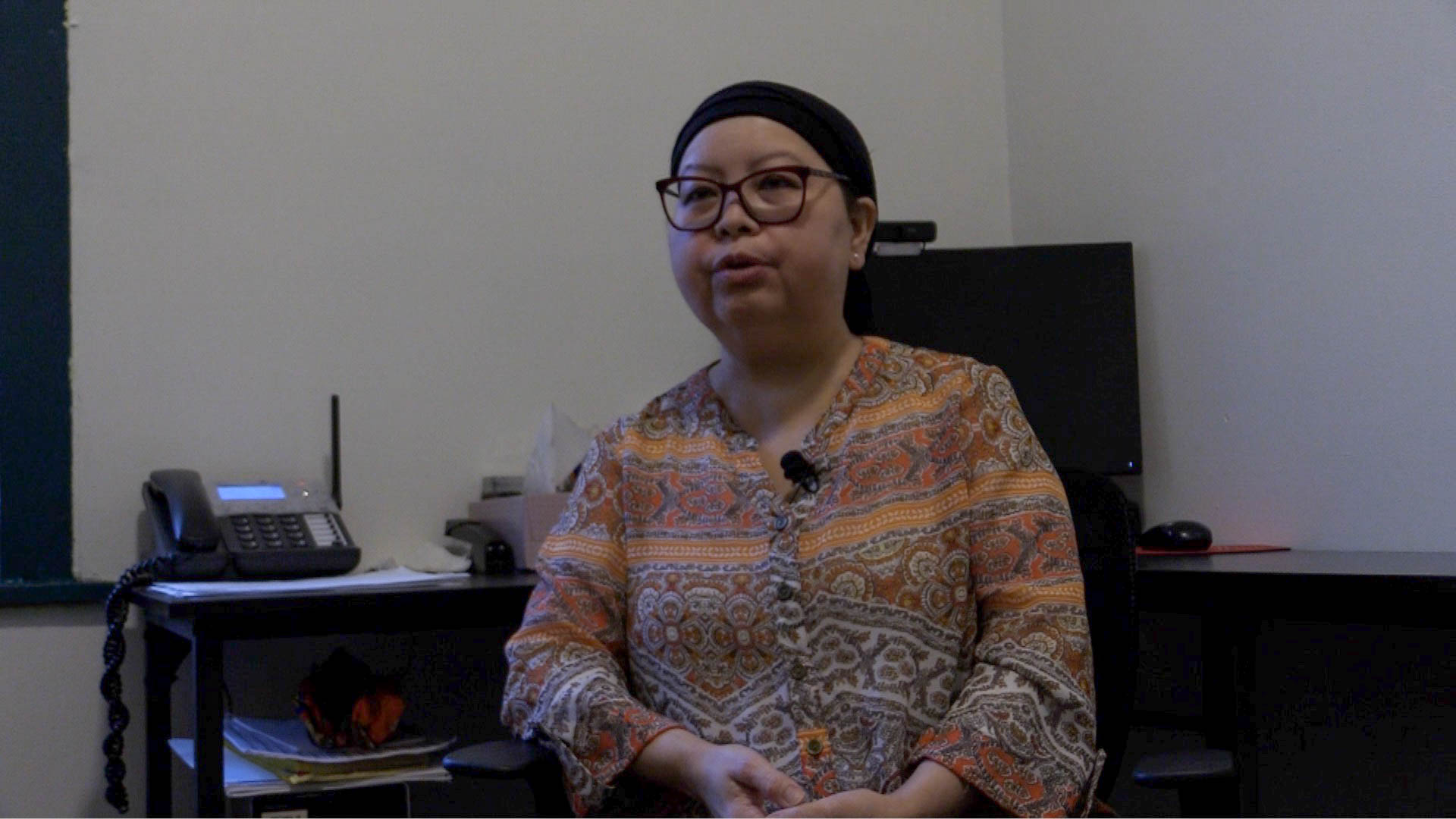
Isilga Odunsi recently had the cost of weatherizing her home completely subsidized by the federal government. "I was very, very grateful for such a program," Odunsi said. Photo by Sarah Tung
Isilga Odunsi’s two-story, red-brick house is meticulously clean, warm and inviting. Ceramic trinkets commemorating her native country, Costa Rica, and framed family photos dominate the china cabinets in the dining room. Odunsi has invested her time and money in making her house a home.
Before her home was retrofitted with weatherproofing materials, many of the rooms were unbearably cold. She opened her home to workers she hired to insulate and weatherize the residence, but they caused more damage than improvements.
“I brought (a) guy in to fix a few things, and he stole a lot of my stuff,” she said with emotion.
Odunsi had just about given up hope for insulating her home until she heard about the Weatherization Assistance Program.
Odunsi talks about why she waited so long to weatherize her home.
WAPIsilgaOdunsiClip1
President Obama’s stimulus bill allocated $5 billion to the 24-year-old program that has been underutilized over the years. This money has triggered some criticism, but it has also made a positive change for community environmental groups and low-income families in New York City.
Weatherization, or weatherproofing, provided through WAP reduces the energy consumption of homes and buildings. The program provides various energy-saving measures, such as air sealing, insulation and general improvements or replacements, specifically to low-income families.
The Weatherization Assistance Program was founded in 1976 and has provided subsidized weatherization services to more than 6.4 million low-income households, though more than 27 million homes remain eligible. Funding for the program varies on the budget set by the presidential administrations, said Joseph Barden, executive director of Margert Community Corporation, a community housing organization in south Queens.
In recent years, WAP’s budget ranged from $200 million to $250 million per year. Obama recognized the importance of helping people overcome income disparities in the move toward energy affordability, so he poured money into the program.
“Sometimes people have to make choices between paying the heating bill and eating,” said Olga Souto, the director of low-income program services at the Community Environmental Center in Queens.
By weatherproofing homes to make them more efficient, people can save hundreds of dollars per month — money that can go toward increasing quality of life. Weatherization helps families afford both.
“Once we insulate a home … you can see a difference (in your electric bill) right away, whether it’s winter or summer,” Souto said. “You’re going to see savings right away, not in two, three years down the line.”
Complications and delays with the distribution of funds and services have been met with criticism from many news organizations. The newly funded weatherization program has not accomplished much since its goal to weatherize 593,000 homes around the country was established last year. According to the Government Accountability Office, only 5 percent of the homes had received WAP services as of Dec. 31, 2009.
Barden, however, disagreed with the negative assessments.
“Stimulus money is going to allows us to get through all the backlog (of homes) that have bene awaiting weatherization,” Barden said. “It’s my anticipation that with this level of funding, everybody (in small family units) who requests weatherization will get it.”
Funding for WAP trickles down from the Department of Energy in Washington, D.C., to state and local government agencies, which then provide grants to nonprofit organizations. Families request and apply for weatherization directly through nonprofit organizations.
In New York, the Division of Housing and Community Renewal handles the allocation of money for the state’s weatherization program. New York received the largest percentage of ARRA funds, about $395 million. In New York City alone, there are 13 nonprofits that receive money.
“The need for weatherization (in New York City) has always vastly exceeded the resource,” Barden said.
But, with the added stimulus funds, more families will finally get help. Barden’s organization was granted $5.4 million to complete 775 units by June 2011; more than 600 of these units are in multi-family projects. He estimated they would overproduce by 10 percent to 12 percent.
DHCR also allocated $21 million in stimulus funds to the Community Environmental Center, which services part of Brooklyn and Queens. The Center’s largest project will be to weatherize and retrofit the 5,881 apartments at Spring Creek Towers, a multi-family housing complex in Brooklyn, by June 2011.
WAP is also an example of how those who live at or below the poverty line can make a conscious effort to be proactive about environmental sustainability. Subsidized weatherization is available, but families have to be active participants to receive government help.
“(We) can only promote (WAP) so much,” Souto said. “But people actually have to look into the program and want to be part of it.”
Clients who wish to receive weatherization assistance have to fill out an application with a local service provider. They must prove their income eligibility by providing pay stubs. If they do not provide these documents, they cannot receive weatherization services. In a multi-family building, such as apartment complexes in New York City, at least half of the families must submit pay stubs.
One of the greatest challenges in the weatherization assistance process lies in education: teaching low-income families how to access information about energy conservation and efficiency, as well as alerting them to energy savings.
“I think (WAP) is a well-kept secret,” Souto said. “I think eventually it’ll evolve into a program that everybody knows about, provided that we put the word out there as much as possible.”
CEC is working to teach its local communities about energy conservation through the Weatherization Assistance Program. Souto said CEC has been forced to promote weatherization services even more since they started spending stimulus money.
“We’re weatherizing at least 400 more clients than normally,” Souto said. “Because of (Obama’s) Recovery Act, all this money has been channeled to (help people) quickly.”
Part of CEC’s outreach program works block by block to teach members of the community about WAP and its benefits.
Odunsi, 61, heard about WAP by word-of-mouth. The elementary school teacher in Flatbush, Brooklyn, had no idea government subsidized weatherization services existed until her daughter, a social worker, told her about the opportunity.

Odunsi points at the compact florescent light bulb that was installed in her home through WAP. Photo by Sarah Tung
Odusni lives with her 74-year-old husband, Bolaji, who has Alzheimer’s. Since her husband’s mental health deteriorated, she has been the only breadwinner in the household. They relocated to the two-story house 11 years ago because of poor conditions in the apartment building they had previously occupied.
“Part of the reason I moved was because it was very cold at times in the winter, and at times we didn’t have water,” she said. “And then another thing, the elevators were not working at times. I had to walk down twelve flights, twelve floors.”
Although it costs a lot more to own a home, Odunsi said the benefits are far greater. Renovating the house, however, caused additional problems.
After hiring people (to weatherize her home) who damaged her walls and windows, or stole precious belongings, Odunsi had run out of money. Because of her past experiences with local contractors, she was extremely skeptical when she first heard about WAP’s free services.
“The first thing I did ask was, ‘What are the fine prints? Are there any strings attached? Are you going to have a lien on my house eventually?’ ” she said.
Despite these doubts, Odunsi was more worried about the cold months ahead.
Odunsi expresses her gratitude for the Weatherization Assistance Program.
WAPIsilgaOdunsiClip2
“I thought I would have waited for like a year because I was becoming very concerned about waiting through another gruesome winter,” she said. Prior to weatherization, the temperature in her home dropped drastically during the colder months of the year, she said. The bedroom she shares with her elderly husband, for example, used to be like a morgue.
What Odunsi discovered, however, was that the federal weatherization program was the most efficient and professional job she’d ever had in her house. Odunsi applied for WAP during summer 2009 and by October, her home had been weatherproofed. Workers installed weatherstripping to doors, replaced windows and screwed in energy saving light bulbs.
“At the beginning, the (energy bill) really went down close to $100 a month,” she said.
In addition to installing weatherproofing technologies, WAP also assessed and retrofitted Odunsi’s home for potential health hazards — an important component of the program that is often overlooked, Barden said.
“Health and safety is our priority within the Weatherization Assistance Program,” Barden said. “It’s often ignored because there’s not an energy factor to it, (but) we’re saving lives, too, you know.”
During a tour of her home, Odunsi pointed at the smoke detector and carbon-monoxide detector mounted in the ceiling of the second floor hallway.
Obama’s American Recovery and Reinvestment Act increased WAP funding assistance from $2,500 to $6,500. Odunsi said it cost about $3,000 to weatherize and retrofit her home, and she did not have to pay a single cent.
“I was very, very grateful for such a program,” she said. “Every time I think about the program, I smile.”


Comments
[…] Pavement Pieces » Blog Archive » Federal funds help with weatherization […]
Great information! I’ve been looking for something like this for a while now. Thanks!